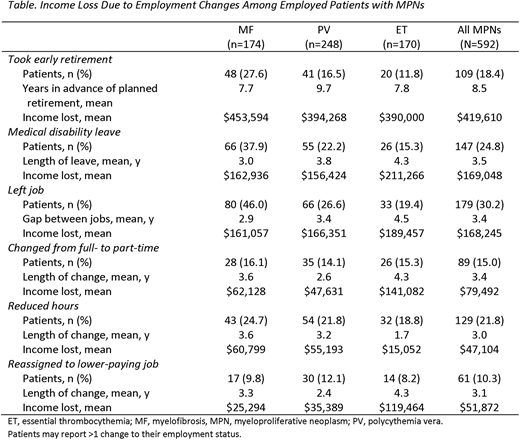Abstract
Background: Patients with myeloproliferative neoplasms (MPNs), including myelofibrosis (MF), polycythemia vera (PV), and essential thrombocythemia (ET), experience a high symptom burden that may compromise daily functioning and quality of life. The objective of this analysis was to evaluate income loss associated with disease-related employment changes among patients with MPNs in the United States.
Methods: The Living with MPN survey was completed online by adult patients (aged 18-70 years) with MF, PV, or ET in the United States between April and November of 2016. Respondents employed at the time of MPN diagnosis were asked questions about disease-related changes in employment status and salaries occurring between diagnosis and the year of survey (2016). In addition, details related to patient demographics, MPN diagnosis, and MPN-related symptoms were collected. Cumulative income losses as a result of disease-related employment changes up to the time of the survey were calculated based on the timing of employment changes and salaries, which were reported in nominal dollars.
Results: Of the 904 survey respondents, 592 (65%) were employed at the time of MPN diagnosis. Among those employed, mean age was 54.0 years, 70.6% were female, and 72.3% were married or had domestic partners at the time of survey. The average duration of disease was 6.1 years (MF, 4.6; PV, 6.9; ET, 6.3). Approximately half (50.5%) of the employed respondents experienced at least one change in employment status because of their diagnosis. Employment status changes and associated impact on income in patients with MPNs was greatest for those who took early retirement, medical disability leave, or left a job due to their disease ($419,610, $169,048, $168,245, respectively). Respondents who changed from full- to part-time employment, reduced hours, or were reassigned to a lower-paying job because of their disease also reported income losses ($79,492, $47,104, $51,872, respectively; Table).
Among respondents who were 45-64 years old at the time of the survey (n=383), 18.8% reported retiring early as a result of their disease. In comparison, according to nationally representative data from the Medical Expenditures Panel Survey (MEPS), only 7.8% of individuals aged 45-64 years in excellent or very good health and 9.2% of individuals in poor health reported being retired (longitudinal data set 2014-2015). Moreover, 30.5% (117/383) of respondents aged 45-64 years in the Living with MPN survey reported leaving a job as a result of their disease. In comparison, 5.5% of MEPS individuals aged 45-64 years in excellent or very good health and 16.4% of individuals in poor health were working at the start of 2014 but not by the end of 2015.
Conclusions: About half of employed patients living with MPNs experienced a variety of employment changes as a result of their disease, which in turn had a considerable impact on income. The most frequently reported disease-related employment change was leaving a job, followed by medical disability leave, reduced hours, early retirement, switching from full-time to part-time, and being reassigned to a lower-paying job. Patients 45-64 years old with MPNs were more than twice as likely to have left a job or retired early compared with an age-matched US general population cohort. On average, the foregone income due to disease-related employment changes was greatest for early retirees ($419,610), followed by those who went on medical disability leave ($169,048), and left a job ($168,245). Early, effective management of MPNs and associated symptoms may help patients avoid these disease-related changes to their employment status and the subsequent economic and financial impact.
Condliffe:Incyte Corporation: Consultancy. Yu:Incyte Corporation: Employment, Equity Ownership. Paranagama:Incyte: Employment, Equity Ownership. Parasuraman:Incyte: Employment, Equity Ownership.
Author notes
Asterisk with author names denotes non-ASH members.


This feature is available to Subscribers Only
Sign In or Create an Account Close Modal